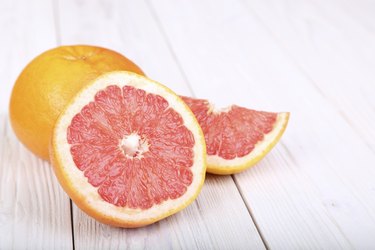
Including more fresh fruits and vegetables in your diet is an easy way to improve your health. The naturally occurring sugar in fruits and vegetables is buffered by the important vitamins, minerals, phytochemicals and fiber that benefit your health. But there are low-sugar fruits and veggies.
Read more: The 10 Healthiest Fruits and Vegetables
Video of the Day
Video of the Day
Try Low-Sugar Fruits
According to the USDA, some citrus fruits, including lemons and limes, are good low-sugar fruit choices with between 1.13 and 5.3 grams of sugar per cup of fruit, or less than 2 grams per 2-inch fruit. Indicated by their sweeter taste, oranges are a little higher in sugar with 13 grams of sugar and grapefruits with 16 grams per 1-cup portion.
Berries are another smart choice for low-sugar fruits; blueberries have 14.7 grams of sugar per cup, blackberries have 7.03 grams and strawberries have 7.43 grams. Cantaloupe, plums, tomatoes, avocados and guavas are other low-sugar fruit options.
Include Low-Sugar Vegetables
Most vegetables are low in sugar, which is evident by their lack of sweetness. When choosing low-sugar vegetables, non-starchy varieties are your best bet, as listed by the American Diabetes Association.
Go for leafy greens, celery, cucumber, squash, carrots, mushrooms, bell peppers, artichokes, leeks, onions, radishes, okra, eggplant, asparagus, beans, beets and broccoli.
Use the Glycemic Index
Some fruits and vegetables may be lower in sugar, but they may still negatively affect your blood sugar levels. You can use the glycemic index, as explained by Mayo Clinic, to figure out which fruits and veggies will have the greatest effect on your blood sugar.
The glycemic index rates carbohydrate foods on a scale of 1 to 100 based on how much the food will affect your blood sugar levels. The lower the number the less the food will raise your blood sugar. Fruits low on the glycemic index include apples, grapefruits, pears, dates and prunes. All non-starchy vegetables are low on the glycemic index.
Avoid These Fruits
Certain fruits are considerably higher in sugar, and some may be high on the glycemic index. If you're watching your sugar intake or working to manage your blood sugar, you should limit or avoid these.
Dried fruits are a concentrated source of sugars. For example, dried mango provides a hefty 48 grams of sugar per 1-cup serving. Many dried fruit products have added sugars in addition to the ones naturally occurring in the fruit.
Bananas are high-sugar fruits with 18.3 grams of sugar per cup, or just about 14.4 grams per one medium banana. Sweet cherries, grapes and pineapple are also high in sugar. Bananas, grapes and watermelon are all moderate- to high-glycemic fruits, which means they can raise your blood sugar.
Steer Clear of these Veggies
When choosing blood sugar-friendly vegetables, avoid starchy veggies like potatoes, corn and sweet potatoes. These vegetables have considerably higher glycemic index values — sweet potatoes have an average rating of 63, and a baked russet potato has an average rating of 78, according to Harvard Health.
Compare that with pure glucose, which has a rating of 100, and you can see how these foods can potentially wreak havoc on your blood sugar. Instead, consider these foods as a source of high carbohydrate similar to grains and starches like pasta.
- American Diabetes Association: "Non-Starchy Vegetables"
- USDA FoodData Central: "Grapefruit, Raw, Pink and Red, All Areas"
- USDA FoodData Central: "Lemons, Raw, Without Peel"
- USDA FoodData Central: "Limes, Raw"
- USDA FoodData Central: "Oranges"
- USDA FoodData Central: "Blackberries, Raw"
- USDA FoodData Central: "Blueberries, Raw"
- USDA FoodData Central: "Strawberries, Raw"
- Mayo Clinic: "Glycemic Index Diet: What's Behind the Claims"
- USDA FoodData Central: "Dried Mango"
- USDA FoodData Central: "Bananas, Raw"
- Harvard Health Publishing: "Glycemic Index for 60+ Foods"
Was this article helpful?
150 Characters Max
0/150
Thank you for sharing!
Thank you for your feedback!